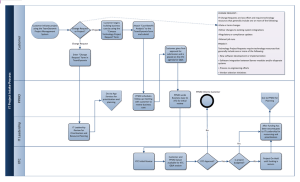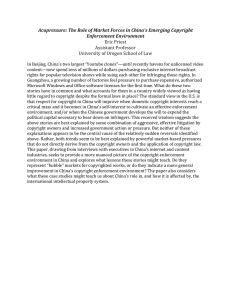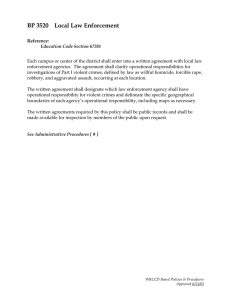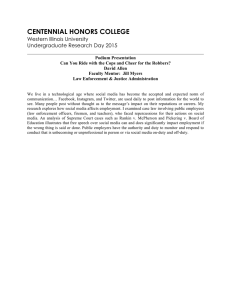R T E S T I M O N... Should the U.S. Direct More Law Enforcement
advertisement
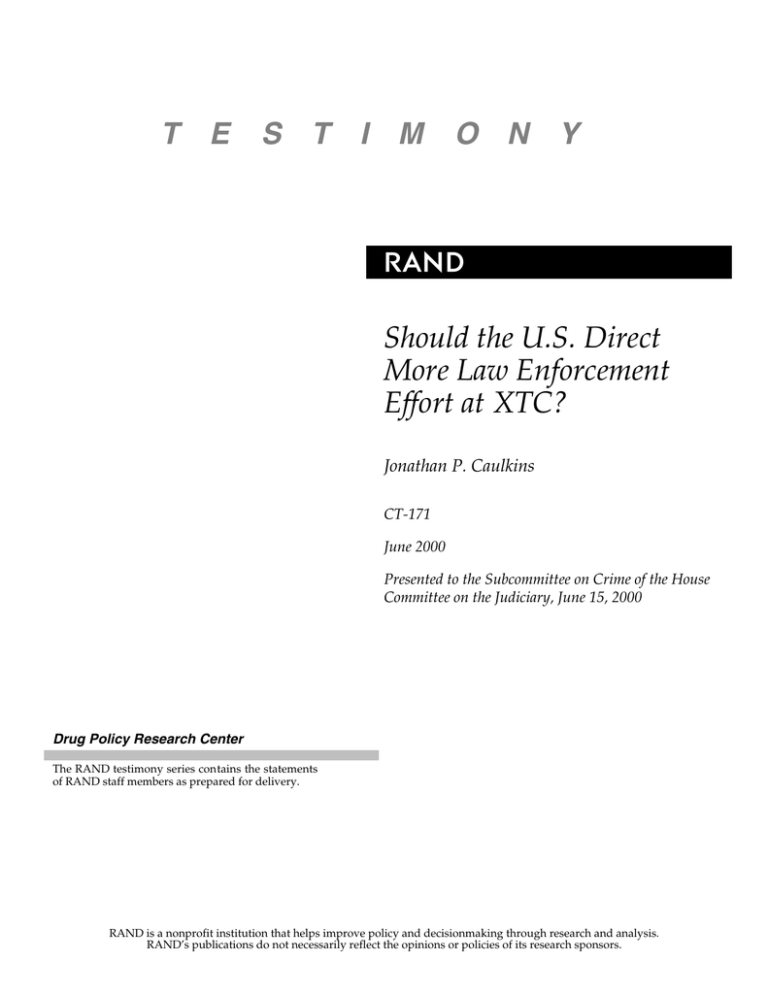
T E S T I M O N Y R Should the U.S. Direct More Law Enforcement Effort at XTC? Jonathan P. Caulkins CT-171 June 2000 Presented to the Subcommittee on Crime of the House Committee on the Judiciary, June 15, 2000 Drug Policy Research Center The RAND testimony series contains the statements of RAND staff members as prepared for delivery. RAND is a nonprofit institution that helps improve policy and decisionmaking through research and analysis. RAND’s publications do not necessarily reflect the opinions or policies of its research sponsors. Should the U.S. Direct More Law Enforcement Effort at XTC? Written Testimony Submitted by Jonathan P. Caulkins RAND, Drug Policy Research Center To the Subcommittee on Crime of the House Committee on the Judiciary Oversight Hearing on “The Threat Posed by the Illegal Importation, Trafficking, and Use of Ecstasy and Other ‘Club’ Drugs,” June 15, 2000 Introduction The question has arisen as to whether this is a good time to direct additional law enforcement effort at XTC. Or, might other interventions, such as treatment and prevention, be better alternatives? One constructive way to approach this question is by stepping back and asking, for what types of drugs and at what point in an epidemic of drug use is law enforcement likely to be the preferred intervention? Then one can ask whether XTC is likely to fit that description. Levels and patterns of drug-use rise and fall over time in modest ways as do all sorts of phenomena, but drug use patterns can also change explosively. In particular, drug “epidemics” can begin with low rates of use being replaced by exponential growth up to some plateau, from which drug use gradually declines to some endemic level that may or may not be much greater than the original level (Musto, 1999). In such a dynamic situation, it may make sense for the mix of policy interventions to vary over time as well. Such adaptive or dynamic policies are not uncommon in other spheres. For example, the Federal Reserve adjusts interest rates in response to its perception of where the economy is in the business cycle. The Recipe for a Drug Epidemic The recipe for a “worst-case” epidemic has the following ingredients. The substance initially has a benign reputation and is perceived to be hip or cool. First use is appealing (not an “acquired taste”) and most users are happy with the drug’s effects during some honeymoon period, but over time some proportion of users suffer substantial ill effects, in the form of addiction (as with heroin), chronic health effects (as with cigarettes), a mixture, or something else. If the proportion suffering ill effects is very large, the drug will acquire a negative reputation fairly quickly. If the proportion is very low, few people will suffer harm. In intermediate ranges, the absolute number of individuals harmed can be large, but they still will not represent the modal outcome. That allows naively optimistic potential users to convince themselves that “it won’t happen to me.” In terms of market conditions, the worst case is a drug that rapidly moves from unavailable to widely available. If the drug has always been available, then older birth cohorts will have already been exposed to the drug. Some individuals will have used. Some will not have. But those cohorts are not susceptible to rapid initiation because most who might consider using the drug have already opted in or out. If the drug was physically unavailable to older birth cohorts, then they can add fuel to the exponential 1 spread of the drug the same way that dead wood accumulating in a forest that is not burned by natural fires can fuel a particularly intense fire when one finally does start. On the other hand, if the availability grows slowly over time, then initially only the most determined or the best-connected potential users will have a chance to start. Their drug use will play out its effects over time before less well-connected individuals have a chance to start. That lets the less-connected individuals witness the end of the “honeymoon period” of relatively happy use and onset of problematic use for some of their colleagues before they themselves decide whether to take a chance by trying the drug. For a drug, population, and market with these characteristics, it is easy to create a positive feedback loop such that some initiation begets more initiation, and drug use sweeps through the population of “susceptibles”. Kleiman (1992) gives an articulate qualitative description of this process, which is captured more formally by models such as those of Behrens et al. (1999, 2000). The key mechanism is reputational. As long as the number of initiates is increasing, most users will have been using for a relatively short period of time and, hence, be in their honeymoon period. That perpetuates the illusion that the drug is safe, inducing still more people to try the drug. The exponential growth is only broken when users begin to manifest obvious problems with the drug or the pool of individuals susceptible to drug use is tapped out. Unfortunately, cocaine in the United States in the 1970s had exactly these characteristics, and initiation grew by more than a factor of 10 during the 1970s. In the 1980s, when the dangers of addiction became more obvious, rates of initiation fell, but by then a large number of people had tried the drug and roughly one-sixth went on to have serious problems with it. Ability of Interventions to Diffuse Epidemic Growth What might the United States have done to avert or at least mitigate its cocaine epidemic? School-based drug prevention programs have been shown in controlled studies to have an effect on initiation into drug use (see, e.g., Ellickson and Bell, 1990; Botvin et al., 1995). However, the median age of cocaine initiation in the United States was 21.5, and the typical school-based drug prevention program is run with 13- or 14year-olds, so prevention is most effective when done about eight years before the rapid increase in initiation. For the U.S. cocaine epidemic, that meant the late 1960s and early 1970s. That lag is problematic because we did not realize we were suffering from a serious cocaine epidemic until the 1980s. Even if we are quicker to recognize an epidemic in the future, there is little one can do about part of the lag. School-based drug prevention may be cost-effective (cf., Caulkins et al., 1999), but it is not an efficient way to focus control on an immediate need. It is also not like a vaccine. Even a cutting-edge prevention program cannot “inoculate” against drug use. Most of those who receive a prevention program who would have used in the absence of the program will still use even if they do receive a cutting-edge prevention program. Other forms of prevention (such as mass-media campaigns) have a shorter lag, or none at all if they are directed not only at teens forming their opinions but also at young adults contemplating trying the drug. However, the evidence concerning their efficacy is thin at best. 2 Treatment is likewise not an effective way of diffusing the epidemic spread of initiation when most people are in the honeymoon period specifically because those who have not yet become dependent and who are not manifesting negative consequences of use generally do not want or perhaps even need treatment. It is even conceivable that, during the explosive-spread stage, helping those who are suffering from drug use could reduce the apparent dangers of the drug, watering down the drug’s negative reputation, and thereby removing a potential brake on the spread of initiation. (Such perverse effects are unlikely later in the epidemic and, at any rate, are purely speculative.) Enforcement, in contrast, has the capacity to focus its effects in the present, to respond quickly, and to be drug specific. Had we directed more enforcement effort at cocaine in the late 1970s, instead of concentrating on heroin and marijuana, it is conceivable that such effort might have slowed the exponential growth through one or more of several mechanisms. The ideal outcome of enforcement is that the substance becomes physically unavailable. If a set of users or potential users has only one point of supply and that supplier is incarcerated, the users might be physically unable to obtain the drug. The same basic principle applies if the users could identify an alternative supplier, but only at some nontrivial cost, effort, or risk (whether of being defrauded or arrested). This decoupling of consumers from the ultimate source of supply is most feasible when the market is “thin” in the sense that there are few alternative suppliers. It would be exceedingly difficult to achieve for cocaine in most parts of the United States today when the typical user may know 10 or 15 alternative suppliers (Riley, 1997). Early in a drug epidemic, before the markets are as well established, it may be more feasible. The second possible beneficial outcome of enforcement is that the risks of sanctions induce suppliers to demand substantial monetary compensation for incurring those risks associated with distributing the drugs, thereby driving up prices (Reuter and Kleiman, 1986). There is good evidence that higher prices suppress use and perhaps even initiation (Chaloupka and Pacula, forthcoming). This so-called “risks and prices” mechanism has been examined by a variety of quantitative models (e.g., Rydell and Everingham, 1994). A consistent finding is that once the market is large, “enforcement swamping” (Kleiman, 1993) makes it very expensive to raise the risk per kilogram delivered enough to greatly increase the price per kilogram or per gram. There is not compelling empirical evidence that enforcement is any more effective at driving up prices of drugs which have a smaller market, but economic logic suggests that it may well be so. A third possible mechanism by which increased enforcement might deter or slow initiation is the direct threat of sanction against users. If users are underestimating the health risks of the drug (e.g., because most of the users they observe are in the honeymoon phase), then creating a criminal justice risk might serve as a useful surrogate to keep potential users from taking foolish risks. In theory, one could even view this as the government compensating for an information failure (ignorance of the long-term health risks of drug use) with a tangible action when its words alone are not credible (e.g., because it cried wolf once too often over the risks of other substances). Of course, if few potential users are deterred and many users suffer severe criminal sanctions, overzealous enforcement against users can make them worse off rather than better off. But enforcement approaches that maximize deterrence relative to 3 sanction, e.g., by focusing on certain rather than severe sanctions, may, particularly if employed at that point in the epidemic, help reduce the aggregate harm suffered by users. Are We on the Brink of an XTC Epidemic? Given this preamble, it is instructive to return to the case of XTC. Do XTC, the XTC markets, and the current population fit the characteristics of a drug that is about to undergo exponential spread of use that will, with the passage of some time, manifest substantial ill effects on users? First consider the question of how harmful or dangerous XTC use is. There are certainly reasons for concern. XTC appears capable of permanently altering the brain. It operates directly on a key component of the brain’s pleasure-control system (serotonin). And users report very down days after their highs in a manner that is reminiscent of the crash that follows a cocaine high. On the other hand, the levels of mortality and morbidity associated with XTC are not extremely high. Furthermore, some perhaps substantial proportion of the adverse drug reactions associated with XTC may actually be attributable to adulterants or polydrug use, and the most common scenario leading to death is dehydration and heat exhaustion – an outcome that could plausibly be addressed through a “harm-reduction” or “safe-use” public health campaign analogous to campaigns against drunk driving.1 At this point I remain agnostic on the issue of how dangerous XTC is. It is clearly not “safe” or risk free. But that is not in question. The question is whether the proportion of users who suffer long-term harm and the scale of those harms will be of the same order of magnitude as with, say, cocaine or heroin. Or will XTC look more like marijuana or even caffeine? One can argue, however, that caution is the preferred approach. If XTC is restricted for 10 more years and turns out not to be terribly dangerous, the cost of that error is less than the cost of not restricting it and finding out 10 years later that it is just as dangerous as cocaine, except that the honeymoon period is longer (and, hence, more deceiving). Is there evidence that any increase in XTC use in the United States fits the pattern of explosive and exponential growth, as opposed to being just a change in tastes or popularity over time that has no substantial self-reinforcing feedback? Again, I must remain agnostic. To paraphrase Mark Kleiman in another context, “The conditions are right for explosive growth. We have no hard evidence of such an explosion in use, but our indicator systems are such that the absence of such evidence is not completely reassuring” (Kleiman and Caulkins, 1992). The conditions are right in the sense that XTC is not widely viewed as a hard or dangerous drug, many first-time users enjoy the drug’s effects, it is associated with youth subculture, and that subculture is believed by some at least to be a trendsetting subculture. On the other hand, XTC is not new in general or in the rave scene. It has been part of U.S. culture for a number of years, and has a deeper and longer-lasting presence in Europe. It is not obvious why use has not exploded already if it has the potential to do so at all. On the other hand, seizures have risen dramatically in the last year or two, and there are plausible stories for a delayed spread, pertaining, e.g., to availability or to greater awareness of the drug due to the Internet. But another scenario 1 Martin Iguchi (personal communication, June 14, 2000) also notes that although animals will selfadminister XTC, they do not persist in use to the extent that they do with other addictive drugs. 4 is that the media have created the illusion of a rapid escalation of use (Jenkins, 1999). If so, the quickest way to solve this drug scare might be to stop paying attention to it. Would Mandatory Minimum Sentences Be an Effective Response? Suppose one did not want to rule out the possibility that XTC has substantial delayed health risks and one believed that its use was spreading explosively. It might be a very appropriate time to direct greater enforcement resources toward XTC. There are several forms those additional efforts could take that might well be useful, such as (1) increasing the number of DEA and Customs agents who are trying to disrupt smuggling of XTC into the country; (2) expanding prosecutorial resources to support such efforts and do a better job of discriminating among truly important versus lesser defendants; and (3) creating sanctions for users that are swift, certain, and not overly draconian. The form of expanded law enforcement that is least likely to be useful is the one the United States has turned to most often in similar situations in the past: extending sentences. Long drug sentences have generally been found to be inefficient at controlling drugs, not only relative to treatment but also relative to other forms of law enforcement (Caulkins et al., 1997). There are many reasons for this, but an obvious one is that the people who get involved in drug markets are not always very farsighted, so the difference between being locked up for five or six years occurs so far in their future that it carries marginal deterrent power. Another is that the sentence length has often been keyed to quantity possessed, which is an unreliable indicator of the importance of the defendant. A courier or mule may be arrested while in possession of large quantities, but if a replacement can be recruited for a few hundred dollars then locking such a person up for 5 or 10 years accomplishes very little.2 More to the point, however, if the goal is to disrupt the epidemic spread by focusing the intervention at this point in time, one would probably rather incapacitate five people for the next 2 years than one person for the next 10. Deterrent effects may manifest at the time of arrest, but not the effects of incapacitation. Does this mean that mandatory minimum sentences are a bad idea for XTC at this point? Not necessarily literally but in practice yes. Literally having some minimum mandatory sentence is not necessarily a bad idea. Too often, convicted drug defendants are simply put on probation, which is neither an effective sanction nor a meaningful control in jurisdictions where probation officers’ caseloads are very high. To avoid this problem, many states have mandatory two-day jail sentences for first-time DUI offenders and mandatory 2–10-day sentences for second-time offenders (Shine and Mauer, 1993). What is problematic with most mandatory drug sentences proposed as a response to an emerging drug threat, besides their being keyed to quantity possessed, is that the 2 The statement of Lewis Rice Jr., Special Agent in Charge of the Drug Enforcement Administration’s New York Field Division, at this hearing is indicative of the problem. Rice describes the investigation of a major XTC smuggling organization based in the Netherlands. This organization offered a “finders fee” of approximately $200 for recruiting a courier, so the loss of a courier’s services costs the organization about $200 in incremental costs. These couriers smuggled between 30,000 and 45,000 pills per trip. Elsewhere, Rice observes that “Base offense level 26 (to which five-year, mandatory sentences are keyed) is reached by trafficking about 28,570 dosage units of MDMA.” Incarcerating someone costs the government about $25,000 per year, so giving a mandatory minimum sentence to a convicted courier, instead of just imposing a short sentence, imposes about $200 in costs on the supplier organization at a cost of about $125,000 to the taxpayers. 5 minimum sentences are much too long. Mandatory minimum drug sentences of 5 or 10 years are too long to be cost-effective for all but a very select group of very high-level cocaine traffickers (Caulkins et al., 1997). (By way of comparison, the average time served for homicide in the United States is about six years.) Being able to threaten defendants with massive sanctions as a way of inducing cooperation is very appealing to law enforcement. In theory, if the very long sentences are never actually used, they can be an efficient tool for prosecutors. However, even leaving issues of constitutionality and civil rights aside, for they are not within my area of expertise, past history is not encouraging. The long sentences are actually given not just threatened, and there is some evidence that the ability to avoid long sentences by turning state’s evidence can even work perversely (Schulhofer, 1993). Regardless, it would be cheaper for taxpayers to greatly expand prosecutorial budgets than to make the existing prosecutors more effective by giving them mandatory minimum sentences as a tool. Buying prosecutorial efficiency at the expense of expanded prison populations is pennywise and pound-foolish given the relative costs of adjudication and incarceration. In summary, if one believed that XTC is likely to turn out to be a very harmful drug (more like cocaine than marijuana in the toll it takes on the average user) and one believed that we are at the brink of an XTC epidemic – two statements about which I am agnostic – then it might make sense to direct more law enforcement effort at XTC at this time. However, even in that case, it still would not make sense for that additional law enforcement effort to take the form of mandatory minimum sentences of the sort we have for cocaine and heroin at the federal level. 6 References: Behrens, Doris A., Jonathan P. Caulkins, Gernot Tragler, Josef Haunschmied, and Gustav Feichtinger. 1999. A dynamic model of drug initiation: Implications for treatment and drug control. Mathematical Biosciences. 159: 1–20. Behrens, Doris A., Jonathan P. Caulkins, Gernot Tragler, and Gustav Feichtinger. 2000. Optimal control of drug epidemics: Prevent and treat – but not at the same time. Management Science. 46 (3): 333–347. Botvin, Gilbert J., E. Baker, L. Dusenbury, E.M. Botvin, and T. Diaz. 1995. Long-term follow-up results of a randomized drug abuse prevention trial in a white middle-class population. Journal of the American Medical Association. 273: 1106–1112. Caulkins, Jonathan P., C. Peter Rydell, Susan M. Sohler Everingham, James R. Chiesa, and Shawn Bushway. 1999. An ounce of prevention, a pound of uncertainty: The costeffectiveness of school-based drug prevention programs, MR-923-RWJ. Santa Monica, CA: RAND. Caulkins, Jonathan P., C. Peter Rydell, William Schwabe, and James R. Chiesa. 1997. Mandatory minimum drug sentences: Throwing away the key or the taxpayers’ money? MR-827-DPRC. Santa Monica, CA: RAND. Chaloupka, Frank J., and Rosalie L. Pacula. Economics and anti-health behavior: The economic analysis of substance use and abuse. In Reframing health behavior change with behavioral economics, ed. W. Bickel and R. Vuchinich. Hillsdale, NJ: Lawrence Earlbaum Associates. In press. Ellickson, Phyllis L., and Robert M. Bell. 1990. Drug prevention in junior high: A multi-site longitudinal test. Science. 247:16–248. Jenkins, Philip. 1999. Synthetic panics: The symbolic politics of designer drugs. New York: New York University Press. Kleiman, Mark A.R. 1992. Against excess: Drug policy for results. New York: Basic Books. _______. 1993. Enforcement swamping: A positive feedback mechanism in rates of illicit activity. Mathematical and Computer Modeling. 17:65–75. Kleiman, Mark A.R., and Jonathan P. Caulkins. 1992. Heroin policy for the next decade. Annals of the American Academy of Political and Social Science. 521:163–174. Kleiman, M.A.R., and K.D. Smith. 1990. State and local drug enforcement in search of a strategy. In Crime and justice: An annual review of research, ed. Norval Morris and Michael Tonry. Chicago: University of Chicago Press. 7 Moore, Mark H. 1973. Policies to achieve discrimination on the effective price of heroin. The American Economic Review. 63 (2): 270–277. Musto, D.F. 1999. The American disease. New Haven: Yale University Press. Reuter, P., and M.A.R. Kleiman. 1986. Risks and prices: An economic analysis of drug enforcement. In Crime and justice: An annual review of research, ed. M. Tonry and N. Morris, 289–340. Chicago: University of Chicago Press. Riley, Kevin Jack. 1997. Crack, powder cocaine, and heroin: Drug purchase and use patterns in six U.S. cities. Washington, DC: National Institute of Justice. Rydell, C. Peter, and Susan M. Sohler Everingham. 1994. Controlling Cocaine: Supply Versus Demand Programs, MR-331-ONDCP/A/DPRC. Santa Monica, CA: RAND. Schulhofer, Stephen J. 1993. Rethinking mandatory minimums. Wake Forest Law Review. 28: 199–222. Shine, Cathy, and Marc Mauer. 1993. Does the punishment fit the crime: Drug users and drunk drivers, questions of race and class. Washington, DC: Sentencing Project. Tragler, Gernot, Jonathan P. Caulkins, and Gustav Feichtinger. Optimal dynamic allocation of treatment and enforcement in illicit drug control. Operations Research. In press. 8
